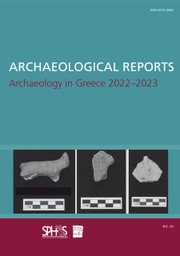No CrossRef data available.
Article contents
Crete (prehistoric to Hellenistic)
Published online by Cambridge University Press: 08 December 2014
Extract
This has been a relatively quiet year in terms of newly-discovered Cretan material appearing for the first time in print. The main event was the continued publication of the backlog of Archaiologikon Deltion with the appearance of the 2005 volume. This, of course, contained a lot less material than last year's volume, which covered four years, 2001–2004. As a result, the disadvantages of late publication were more apparent, since all the most notable finds will already be known to the wider community from other sources, leaving only the most minor of rescue excavations as truly new material.
Galatas provides a good example as one of the major Bronze Age sites being excavated in 2005 (ID4536). The excavation witnessed an important new discovery in the form of a monolithic “baetyl” and associated exedra to the south of the site's central building. The value of this discovery is that it adds to a relatively small corpus of enigmatic unhewn monolithic stones that appear as focal points in open-air public spaces in Minoan settlements. As such, it adds considerably to our understanding of the type, especially because, more so than in other places, signs of the activities associated with it appear to be preserved. This very important find has already made it into the secondary literature, being one of the primary case studies in Sam Crooks” (2013) book on Minoan baetyls. Less widely known are the results of the Galatas survey (ID4537), which appear in this year's ADelt in a preliminary form. Intriguing is the statement that the number of sites around Galatas increases sharply in the Neopalatial period, and that many of them are large. Galatas itself has a rather rocky Neopalatial history and in the fullness of time it will be interesting to see whether the story from the site and that from the wider area coincide, or whether there is some opposing or complementary dynamic. Also of great potential importance is the mention of a Minoan mason's mark in a quarry that is interpreted as providing blocks for the central building at Galatas. Masons” marks have been the centre of controversy ever since they were first discovered, with the majority of scholars interpreting them as in some way religious, whilst a few have suggested instead that they had some more practical purpose, relating to the work crews constructing monumental buildings (a good up-to-date treatment with previous bibliography is Begg 2004). If this identification is confirmed, it might significantly strengthen the minority side of the argument.
- Type
- Archaeology in Greece 2013–2014
- Information
- Copyright
- Copyright © Authors, the Society for the Promotion of Hellenic Studies and the British School at Athens 2014




